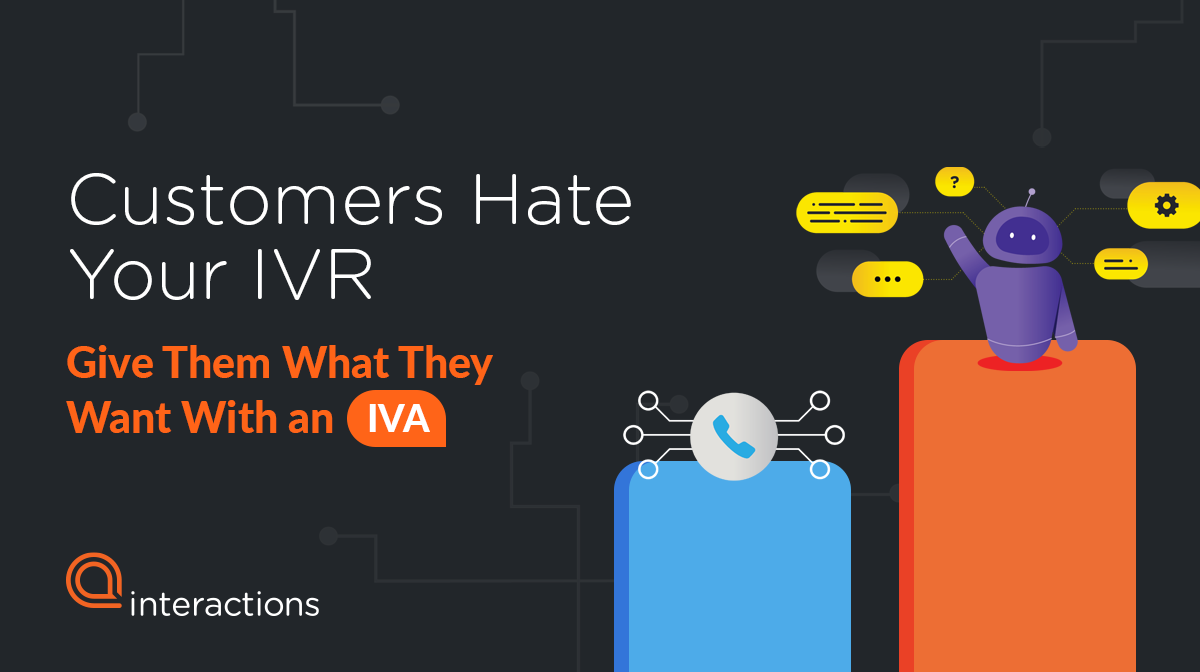We’ve all had frustrating experiences when contacting businesses for help (and if you haven’t, consider yourself lucky.) Maybe you spent forever on hold, or your issue was not actually solved, or you were left sifting through service options that had nothing to do with what you were calling about.
The time that your customer takes to reach out for help is a valuable opportunity that all companies should capitalize on. Sending your customer through mazes to try to find an answer or having to sift through menu options on an IVR can create negative impressions that cause your customer to go elsewhere.
But automation doesn’t have to be a negative experience. According to Gartner, by 2020, approximately 86% of a customer’s relationship with a company will occur without the customer interacting with a human. Companies have the opportunity to make these interactions positive by implementing an intelligent and conversational virtual assistant. Done correctly, an automated virtual assistant can actually create a better customer experience than a human can.
First thing first. What is an IVR system?
A traditional IVR system, or interactive voice response, is a rule-based system that responds to speech or touch-tone. They are limited to the dialogue that they were originally programmed with. You’ve probably come in contact with one before, for example a speech-enabled IVR would present menu options such as pay a bill or check your account balance when you call your bank. IVR systems could also be touch-tone, where the prompt would say press 1 to pay your bill, press 2 to check your account balance, etc. The drawback is that the system will only understand those specific phrases. If you go off-script, there is no way for the IVR system to understand what you are trying to say.
Disadvantages of IVR systems
It’s pretty obvious how a system like this can fail. Even if a user were to mispronounce a phrase or if they have a heavy accent, the system will not be able to compute the utterance. Then, not only have you added an extra step in the customer journey, but your customer will most likely have a long wait time before connecting with a live agent. This creates a terrible customer experience.
This happens because many companies that use IVR systems rely solely on Automatic Speech Recognition (ASR) without Natural Language Processing (NLP). This means that the IVR can hear the speech and respond if it is a pre-programmed option, but it cannot truly understand what is being said. Without the ability to understand, the IVR will also never reach a conversational level that many consumers are looking for.
So why are companies still using IVR systems?
The simple answer is because they are looking for a way to automate simple tasks or direct call traffic to live agents. Because of their limitations in handling complex tasks, IVRs are not handling queries, they are simply acting as a traffic guide to usher customers through the customer care maze.
Another reason is that there is no limit to the amount of calls that an IVR is able to handle. This allows companies to scale their contact centers and interact with many more customers. However, according to the 2018 CFI Contact Center Satisfaction Index, 88% of users who reach an IVR end up talking to a live agent to resolve their issue. So while contact centers will be able to take many more calls, they are still limited by the bandwidth of their live agents.
Companies are also still using IVR systems because they are not aware of better options that are available. Many contact centers are still stuck in the mindset of containing and deflecting customers. With updated technologies, companies will be able to shift that mindset to engage and delight which creates a better customer experience.
Choose a technology that advances your customer experience
So what elements of a virtual assistant are necessary to shift the mindset to engaging and delighting customers?
Conversational
The first is that we must consider the fact that many customers don’t want to change the way that they think and speak to interact with technology. Customer prefer automation that is conversational and natural.
In order for that to happen, the system must do more than simply hear what customers say. It must be able to understand on a human level. The system must use conversational AI technologies such as automated speech recognition (ASR) and Natural Language Understanding (NLU) to understanding even complex intents, and Natural Language Generation (NLG) and Dialog Management to respond in a natural and coherent way. The system must also understand its limitations and get human assistance when necessary. This allows for customers to be able to speak the way they want, instead of having to prescribe to set list of options.
Personalized
Another consideration is that the system should seamlessly interact with client’s back office systems in real time to offer a personalized experience. That way customers will not have to recount information that should already be known.
Future Proof
Lastly, companies should look for systems that are able to grow with the company. Flexibility, such as the ability to support more channels or expand to multiple languages, is important to allow for growth.




